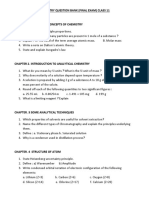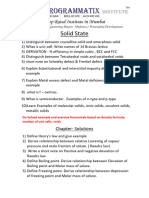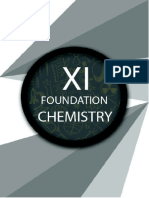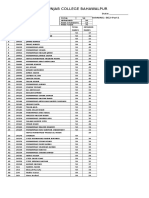FSC Paper
FSC Paper
Uploaded by
Rana Hassan TariqCopyright:
Available Formats
FSC Paper
FSC Paper
Uploaded by
Rana Hassan TariqOriginal Description:
Original Title
Copyright
Available Formats
Share this document
Did you find this document useful?
Is this content inappropriate?
Copyright:
Available Formats
FSC Paper
FSC Paper
Uploaded by
Rana Hassan TariqCopyright:
Available Formats
COMPLETE PARING 1-7 CHAPTER WITH SHORT AND LONG
Part 1:
1.
2.
3.
4.
5.
6.
7.
8.
9.
10.
11.
12.
Why actual yield is usually less than the theoretical yield?
One mole of CO2 and NO2 have same number of molecules. Why?
Define actual yield, write formula for the calculation of percentage yield.
Define limiting reactants. How they can be identified?
No individual neon atom in the sample of the element has a mass of 20.18 a. m. u. Discuss.
Define adsorption and partition chromatography.
Rf Value is always less than I. O. comment on it.
Differentiate between stationary and mobile phase. Also write an example of each phase.
Naphthalene can best be purified by sublimation. Why?
Give the four uses of paper chromatography.
Mention the major steps involved in crystallization.
Explain the process of sublimation.
Part 2:
1.
2.
3.
4.
5.
6.
7.
8.
9.
10.
11.
12.
13.
Part 3:
1.
2.
3.
4.
5.
6.
7.
8.
9.
10.
11.
Why pressure correction is done by van der Waals?
Differentiate between diffusion and effusion of the gases.
What do you mean by Absolute zero?
Give mathematical expression for mean square velocity and root mean square velocity.
Joule Thomson effect is operative in the Lindens Method of liquefaction of air. How?
State what is natural and artificial plasma?
Water freezes from surface to the downward direction in Ponds and Lakes. Explain why?
Why do we feel uncomfortable breathing at higher altitude?
How in very cold winter fish in garden ponds owe their lives to hydrogen bonding?
One feels sense of cooling under the fan after bath. Why?
Justify that HF is a weak acid than HCl.
How liquid crystals are used as a locator of tumors?
How in very cold winter fish in garden ponds owe their lives to hydrogen bonding?
Define Heisenberg uncertainty principle.
Positive rays are also called canal rays. Give reason.
Why e/m value of the cathode rays is just equal to that of electron?
What are defects in Rutherfords atomic model?
What is importance of Moseley law?
How you can compare orbit and orbital?
Differentiate between Stark effect and Zeeman Effect.
State Pauli Exclusion Principle and Hunds rule.
Give two postulates of Plancks Theory.
Make difference between line spectrum and continuous spectrum.
State Auf bau principle and Paulis exclusion principle.
12.
Define dipole moment. Give its various units..
13.
Why Pi ( ) bonds are diffused than sigma ( ) bonds?
14.
No bond in chemistry is 100% ionic. Justify it.
15.
Why the dipole moment of CO2 is zero and that of H2O is 1.85D?
16.
Why nitrogen molecule is diamagnetic?
17.
Write two points of Valence Bond Theory.
18.
The bond angels of H2O and NH3 are not 109.5o like that of CH4, although oxygen and nitrogen atoms are sp3
hybridized. Why?
19.
Write down two postulates of VSEPR theory.
20.
Helium is diamagnetic in nature, Justify.
Part 4:
1. Temperature is a state function but heat is not. Why?
2. Define system and surrounding with one example each.
3. Define enthalpy of formation (
Hof) and enthalpy of atomization (
Hoat)
4. Define first law of thermodynamics. How it is represented?
5. Differentiate between internal energy and enthalpy.
6. Explain that burning of a candle is spontaneous process.
7. What is the physical significance of equation,
H = qp?
8. Draw labeled diagram of bomb calorimeter.
9. Define Hesss law of constant heat summation with one example.
10. Spontaneous reaction always proceeds in the forward direction. Give reason.
Lec.Rana Muhammad Hassan Tariq
COMPLETE PARING 1-7 CHAPTER WITH SHORT AND LONG
Chapter 1:
1.
2.
3.
Glucose C6 H12 O6 is the most important nutrient in the cell for generating chemical
potential energy. Calculate the mass% of each element in glucose and determine the
number of C,H and O atoms in 10.5g go the sample.
A mixture of two liquids, hydrazine N2H4 and N2 O4 are used as a fuel in rockets. They
produce N2 and water vapors. How many grams of N2 gas will be formed by reacting 100g of
N2 O4 and 200g g of N2 O4.
Calculate the number of grams of A1 2 S3 which can be prepared by the reaction of 20 g of
A1 and 30 g of sulphur. How much the non-limiting reaction is in excess?
4. Mg metal react with HC l
solution (27% by weight) required to produce 12. 1g of H2. The density of HC l
solution 1.14g/cm3.
Mg(s) + 2HC l
(aq)
Mg C2 l
(aq)
+H2(g)
Chapter 4:
1.
2.
3.
4.
Define and explain London dispersion forces. What are the factors which affect London forces? Discuss briefly.
What are covalent solids? Discuss the structure of Diamond.
Define Vapour pressure. Describe manometric method for the measurement of vapour pressure.
Define metallic bond. Justify the electrical conductivity, thermal conductivity and shining surfaces of metals.
Chapter 3:
1. State Grahams law. Explain Grahams law of diffusion according to kinetic equation.
2. Describe postulates of kinetic molecular theory of gases.
3. Describe Daltons law of partial pressure. Write its all applications.
4. State and explain Grahams law of diffusion of gases.
Chapter 5:
1. Explain Millikans oil drop experiment to determine charge of the electron.
2. Derive radius of revolving electron in nth orbit of an atom.
3. (i) Write three points of Plancks quantum theory.
(ii)
Define frequency and wavelength.
4. Write down the defects in Bohrs atomic mode.
5. Derive the formula of calculating the energy of an electron in nth orbit of H atom using Bohrs model.
Chapter 6
1. What is dipole moment? Give its units. Explain the structure of CO2 FB3 and H2O on the basis of dipole moment.
2. Define hybridization. Explain the Sp2,Sp3,Sp with their examples
3. How will you describe the paramagnetic character of oxygen on the basis of MOT?
4. Write the postulate of VSEPR theory and discuss the structure of NH3 with reference to this theory.
Chapter 7
1. State first law of thermodynamics. How does it explain that q p =
2. Discuss first law of thermodynamic and prove that
E = qv
3. How does Born Haber cycle help to calculate lattice energy of NaCl?
4. Define the following giving one example in each:
a. (i)
enthalpy of solution
(ii)
Enthalpy of atomization
b. (iii)
System
(iv)
Surroundings
5. Write a note on construction and working of bomb calorimeter.
6. Define the following:
(i)
Standard Enthalpy of neutralization with example.
(ii)
Standard enthalpy of combustion with example.
Lec.Rana Muhammad Hassan Tariq
You might also like
- JR Chemistry - Chapter Wise Important Questions - Part 1Document21 pagesJR Chemistry - Chapter Wise Important Questions - Part 1githa80% (356)
- ACI Diploma Sample QuestionsDocument7 pagesACI Diploma Sample Questionsattractram100% (1)
- 1st Year Guess ChemDocument6 pages1st Year Guess ChemMuhammad RamzanNo ratings yet
- Guess Paper First Year ChemistryDocument7 pagesGuess Paper First Year ChemistryJunaid YusfzaiNo ratings yet
- 11TH Class Chemistry Guess Paper 2022 1Document8 pages11TH Class Chemistry Guess Paper 2022 1mtayyabestNo ratings yet
- IPE Important QuestionsDocument6 pagesIPE Important Questionsprarthana200403No ratings yet
- Half Yearly Chapterwise Important QuestionsDocument4 pagesHalf Yearly Chapterwise Important Questionsfood loverNo ratings yet
- Chemistry AssignmentsDocument14 pagesChemistry Assignments8c30 Susheel kumarNo ratings yet
- Chemistry Target Paper by Engr - Madiha Ahmed - 064534Document4 pagesChemistry Target Paper by Engr - Madiha Ahmed - 064534zoodiaamoNo ratings yet
- First Year Chemistry Very Important Questions Half YearlyDocument3 pagesFirst Year Chemistry Very Important Questions Half Yearlyhyper5350No ratings yet
- SLO's Based Question Chem XIDocument5 pagesSLO's Based Question Chem XISingularityNo ratings yet
- Chapter 1-Atomic Structure: Four (4) Marker QuestionsDocument11 pagesChapter 1-Atomic Structure: Four (4) Marker Questionsisaacvivek7093No ratings yet
- 11 ChemistryDocument8 pages11 ChemistrydhanushbodybuilderNo ratings yet
- Chemistry 11 TH 12 THDocument52 pagesChemistry 11 TH 12 THSudhir ChhetriNo ratings yet
- JR Chemistry Chapter Wise Important Questions Part 1Document21 pagesJR Chemistry Chapter Wise Important Questions Part 1ntofficial18No ratings yet
- 1st Year Chemistry GuessDocument5 pages1st Year Chemistry GuessMuhammad Ishtiaq100% (2)
- I Year Chemistry-1Document4 pagesI Year Chemistry-1sanafatimasw1No ratings yet
- 1st Year Chemistry GuessDocument8 pages1st Year Chemistry GuessZobia AsgharNo ratings yet
- ChemistryDocument3 pagesChemistryAfsar100% (1)
- !ST Year Chemistry Guess Paper - UmarDocument15 pages!ST Year Chemistry Guess Paper - UmarHafiz Muhammad Umar AslamNo ratings yet
- JR Inter MPCDocument7 pagesJR Inter MPCPavankumar Harsha100% (1)
- CLASS 1st YEAR FULL BOOK FLPDocument2 pagesCLASS 1st YEAR FULL BOOK FLPZAHEER RAJPOOTNo ratings yet
- Important PU QuestionsDocument16 pagesImportant PU Questionsbyagnitha168No ratings yet
- JR. CHEMISTRY Important QuestionsDocument8 pagesJR. CHEMISTRY Important QuestionsRocky Water0% (1)
- SR Inter CHEMISTRY IMP-New With 70% Syllabus-Converted-1Document6 pagesSR Inter CHEMISTRY IMP-New With 70% Syllabus-Converted-1B. SwapnaNo ratings yet
- 1st Puc Chemistry Fix QuestionsDocument4 pages1st Puc Chemistry Fix QuestionserannakalivalNo ratings yet
- Chemistry Question Bank (Final Exam) Class 11Document7 pagesChemistry Question Bank (Final Exam) Class 11Sunit KumarNo ratings yet
- Chemistry Question BankDocument3 pagesChemistry Question BankquadrimufeezNo ratings yet
- 3 Mark QuestionsDocument5 pages3 Mark QuestionstcesatishNo ratings yet
- Wa0000.Document9 pagesWa0000.Ramya. RNo ratings yet
- 11th Chemistry Guess 2023Document4 pages11th Chemistry Guess 2023muddassaryasinpakssgforce78No ratings yet
- Junior Chemistry Quarterly Exam Important Questions 2023Document2 pagesJunior Chemistry Quarterly Exam Important Questions 2023wahajk504100% (1)
- TOPIC OF THE DAY (1)Document5 pagesTOPIC OF THE DAY (1)punarvasu999No ratings yet
- Chemistry Board Question BankDocument12 pagesChemistry Board Question Banktirthsonani1908No ratings yet
- Best XI Group Long QuestionsDocument1 pageBest XI Group Long Questionsusman6969696969No ratings yet
- JR ImpDocument8 pagesJR ImpGovindu PrathapNo ratings yet
- 1st PUC chemistry passing packageDocument12 pages1st PUC chemistry passing packageramprasad_kNo ratings yet
- Xi Chemistry Imp 2024Document5 pagesXi Chemistry Imp 2024mohammadatifkhan82No ratings yet
- Jrchemistry Important QuestionsDocument8 pagesJrchemistry Important Questionsprem81% (16)
- Chapter 3Document2 pagesChapter 3Naveed ZafarNo ratings yet
- 1st Year Chemistry Guess Paper 2022Document6 pages1st Year Chemistry Guess Paper 2022mtayyabestNo ratings yet
- Chapter # 1 ChemDocument3 pagesChapter # 1 ChemRana Hassan TariqNo ratings yet
- Junior Chemistry Smart AcademyDocument8 pagesJunior Chemistry Smart Academyaheadkhan593No ratings yet
- 1st Year Chemistry Guess Paper 2022Document6 pages1st Year Chemistry Guess Paper 2022ahsansaddiqi2k23No ratings yet
- Kinematics of SootDocument43 pagesKinematics of Sootstructuredes.1No ratings yet
- Some Basic Concepts of Chemistry: One Mark QuestionsDocument9 pagesSome Basic Concepts of Chemistry: One Mark QuestionsTanvi KishoreNo ratings yet
- First Yeat EM IMP Questions 23-24Document5 pagesFirst Yeat EM IMP Questions 23-24barevishnuvardhan2007No ratings yet
- Chemistry-1st PU: 2&3 Marks Important QuestionsDocument9 pagesChemistry-1st PU: 2&3 Marks Important QuestionsDaksha SubrhamanyaNo ratings yet
- Chemistry 1st Year Important QuestionsDocument4 pagesChemistry 1st Year Important Questionsnagendra.palle8No ratings yet
- SPM Chemistry Revision Module On The BasicsDocument64 pagesSPM Chemistry Revision Module On The BasicsMThana BalanNo ratings yet
- SPM Chemistry Revision Module On The BasicsDocument64 pagesSPM Chemistry Revision Module On The Basicssuritanu96No ratings yet
- Class 11 Chemistry WorkbookDocument163 pagesClass 11 Chemistry WorkbookParam100% (1)
- XI Chemistry Basic Basic QuestionsDocument8 pagesXI Chemistry Basic Basic QuestionsBichitra GautamNo ratings yet
- 1st Pu Chapter Wise QuestionsDocument13 pages1st Pu Chapter Wise QuestionsMir RayyanNo ratings yet
- Chemistry-1 Important Questions IPE 2023-1Document2 pagesChemistry-1 Important Questions IPE 2023-1telukuntlasaivardhanNo ratings yet
- States of Matter & 6. Thermodynamics11CHEMISTRYDocument4 pagesStates of Matter & 6. Thermodynamics11CHEMISTRYredoxreactionsNo ratings yet
- Long Answers: Cac A B Ethylene DDocument4 pagesLong Answers: Cac A B Ethylene DAkkireddi AnilNo ratings yet
- Physical and Chemical Equilibrium for Chemical EngineersFrom EverandPhysical and Chemical Equilibrium for Chemical EngineersRating: 5 out of 5 stars5/5 (1)
- Time-Resolved Mass Spectrometry: From Concept to ApplicationsFrom EverandTime-Resolved Mass Spectrometry: From Concept to ApplicationsNo ratings yet
- A Modern Course in Statistical PhysicsFrom EverandA Modern Course in Statistical PhysicsRating: 3.5 out of 5 stars3.5/5 (2)
- Chapter 5Document20 pagesChapter 5Rana Hassan TariqNo ratings yet
- Numerical of ExerciseDocument14 pagesNumerical of ExerciseRana Hassan Tariq100% (3)
- Date Subject 1 Year 2 Year: Te ST N oDocument3 pagesDate Subject 1 Year 2 Year: Te ST N oRana Hassan TariqNo ratings yet
- School Leaving CertificateDocument1 pageSchool Leaving CertificateRana Hassan TariqNo ratings yet
- Introduction To Experimental TechniquesDocument25 pagesIntroduction To Experimental TechniquesRana Hassan TariqNo ratings yet
- 2nd Year Math Chap No.4 (Ex 4.4, 4.5) 5Document3 pages2nd Year Math Chap No.4 (Ex 4.4, 4.5) 5Rana Hassan TariqNo ratings yet
- Chemistry Book 2 Chapter - 15 (Common Chemical Industries in Pakisten)Document55 pagesChemistry Book 2 Chapter - 15 (Common Chemical Industries in Pakisten)Rana Hassan TariqNo ratings yet
- Term Test For GM1 and BM1 Chemistry ch1,2,7,8,9Document3 pagesTerm Test For GM1 and BM1 Chemistry ch1,2,7,8,9Rana Hassan TariqNo ratings yet
- Chapter 01Document5 pagesChapter 01Rana Hassan TariqNo ratings yet
- CH 6 TRANSITION ELEMENTSDocument4 pagesCH 6 TRANSITION ELEMENTSRana Hassan TariqNo ratings yet
- 1 Year: Q Nso: 1 Encircle The Correct Answer.Document1 page1 Year: Q Nso: 1 Encircle The Correct Answer.Rana Hassan TariqNo ratings yet
- CH-8 O.KDocument26 pagesCH-8 O.KRana Hassan TariqNo ratings yet
- Ist Year FLP 2 Physics CompleteDocument2 pagesIst Year FLP 2 Physics CompleteRana Hassan Tariq100% (1)
- Full Book Test Chemistry DDocument1 pageFull Book Test Chemistry DRana Hassan TariqNo ratings yet
- CH 1Document34 pagesCH 1Rana Hassan Tariq100% (1)
- Punjab College Bahawalpur: Student Award List Date: Session: 2015-2016 Class: FSCE-MORNING: BE2-Part1Document1 pagePunjab College Bahawalpur: Student Award List Date: Session: 2015-2016 Class: FSCE-MORNING: BE2-Part1Rana Hassan TariqNo ratings yet
- AstromaniaDocument2 pagesAstromaniaRana Hassan TariqNo ratings yet
- Punjab College Bahawalpur BSC-Applied Chemistry: Chemical RequiredDocument1 pagePunjab College Bahawalpur BSC-Applied Chemistry: Chemical RequiredRana Hassan TariqNo ratings yet
- Certificate of Appreciation 03Document1 pageCertificate of Appreciation 03Rana Hassan TariqNo ratings yet
- Precipitation Reactions BasicDocument2 pagesPrecipitation Reactions BasicRana Hassan TariqNo ratings yet
- Chapter # 1 ChemDocument3 pagesChapter # 1 ChemRana Hassan TariqNo ratings yet
- Punjab College Bahawalpur: Department: ChemistryDocument1 pagePunjab College Bahawalpur: Department: ChemistryRana Hassan TariqNo ratings yet
- CH # 2 Experimental Techniques in ChemistryDocument10 pagesCH # 2 Experimental Techniques in ChemistryRana Hassan TariqNo ratings yet
- 2nd Year English Test 6Document2 pages2nd Year English Test 6Rana Hassan TariqNo ratings yet
- Nitration of Benzene:: Discuss The Mechanism of Above Reaction in Three StepsDocument2 pagesNitration of Benzene:: Discuss The Mechanism of Above Reaction in Three StepsRana Hassan TariqNo ratings yet
- DistillationDocument3 pagesDistillationRana Hassan TariqNo ratings yet
- BM 4Document2 pagesBM 4Rana Hassan TariqNo ratings yet
- 2nd Year English Test 5Document2 pages2nd Year English Test 5Rana Hassan TariqNo ratings yet
- BidFile 100Document816 pagesBidFile 100Ed SalangaNo ratings yet
- Mcmurry Oc8e Ev Ch01Document10 pagesMcmurry Oc8e Ev Ch01Thuận Võ NgọcNo ratings yet
- Mystery of Solubility - Retrograde (Temperature Inverse) Solubility - Why Does It Happen - Nikhilesh Mukherjee - Pulse - LinkedInDocument6 pagesMystery of Solubility - Retrograde (Temperature Inverse) Solubility - Why Does It Happen - Nikhilesh Mukherjee - Pulse - LinkedInmtaha85No ratings yet
- 4 Valuation of SecuritiesDocument13 pages4 Valuation of SecuritiesPhạm Trần Thanh TúNo ratings yet
- Worldwide Paper CompanyDocument2 pagesWorldwide Paper Companyecineko100% (1)
- Chapter 2 PHY 351Document54 pagesChapter 2 PHY 351aimiNo ratings yet
- Endothermic.: A The Forward Reaction IsDocument9 pagesEndothermic.: A The Forward Reaction IsSatyrKuangNo ratings yet
- Fixed Income SecuritiesDocument1 pageFixed Income SecuritiesRaghuveer ChandraNo ratings yet
- Encroachment Permits Manual - Chapter - 2Document47 pagesEncroachment Permits Manual - Chapter - 2prowagNo ratings yet
- Carbonyl Condensation ReactionsDocument41 pagesCarbonyl Condensation ReactionsVladislav PapperNo ratings yet
- VBTDocument40 pagesVBTLohith LoliNo ratings yet
- Uzgtl-Com-F2-0104 - Epc Itb - Att 1 - Forms of Bid - Rev1Document10 pagesUzgtl-Com-F2-0104 - Epc Itb - Att 1 - Forms of Bid - Rev1Hyun Jin YooNo ratings yet
- Chapter 2 Answers PearsonDocument5 pagesChapter 2 Answers PearsonKunakorn KunthamasNo ratings yet
- Financial Instruments: Priya Tiku MBA-FinanceDocument17 pagesFinancial Instruments: Priya Tiku MBA-Financemokshgoyal2597No ratings yet
- Bankruptcy Prediction Models and The Cost of Debt: Sattar A. Mansi, William F. Maxwell, and Andrew ZhangDocument34 pagesBankruptcy Prediction Models and The Cost of Debt: Sattar A. Mansi, William F. Maxwell, and Andrew ZhangJeffrey WilliamsNo ratings yet
- Geology & MineralsDocument17 pagesGeology & MineralsShekh Muhsen Uddin AhmedNo ratings yet
- Duration Times SpreadDocument24 pagesDuration Times SpreadfrolloosNo ratings yet
- Morning Review - 090110Document10 pagesMorning Review - 090110pdoorNo ratings yet
- Rule 58, Rules of Court (Preliminary Injunction and Restraining Orders)Document7 pagesRule 58, Rules of Court (Preliminary Injunction and Restraining Orders)Vet LimNo ratings yet
- Chapter 6 Section 2 OutlineDocument4 pagesChapter 6 Section 2 Outlineapi-263455041No ratings yet
- Asset Backed Securitization in BangladeshDocument22 pagesAsset Backed Securitization in BangladeshA_D_I_BNo ratings yet
- Soal KimdasDocument13 pagesSoal KimdasNur SyahrainiNo ratings yet
- Introducing Green Bond in BangladeshDocument19 pagesIntroducing Green Bond in BangladeshAshiq Rayhan0% (1)
- Essay On Conducting PolymersDocument7 pagesEssay On Conducting Polymerssjktnknsjgrg100% (1)
- Finance Sample Paper QuestionsDocument15 pagesFinance Sample Paper QuestionsEve LNo ratings yet
- Managerial Finance Gitman E12 Ch06Document14 pagesManagerial Finance Gitman E12 Ch06Klyde Mercado Macaraig100% (2)
- Lecture 5 - Bonds & Bond Analysis: Investment BankingDocument14 pagesLecture 5 - Bonds & Bond Analysis: Investment Bankingedsan 1988No ratings yet
- Bond DurationDocument2 pagesBond DurationBalasingam PrahalathanNo ratings yet
- Organic Chemistry 3A Additional Problems Final Exam Part 1Document7 pagesOrganic Chemistry 3A Additional Problems Final Exam Part 1John SmithNo ratings yet




















































































































